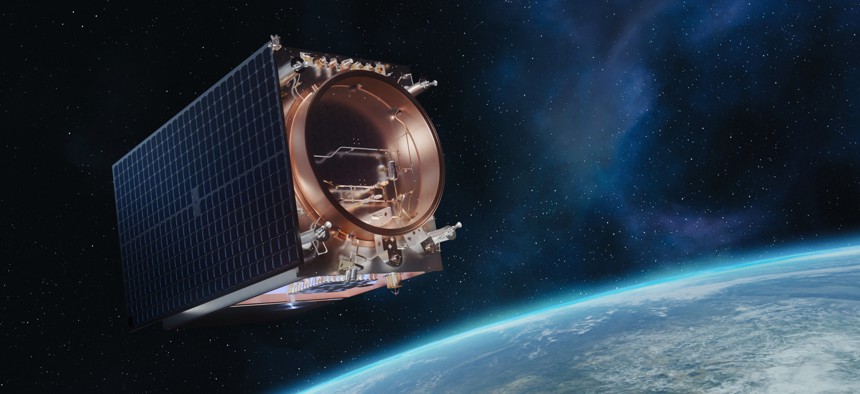
An artist's conception of the Lockheed Martin LM 400 Mid-Sized Multi-Mission Satellite Bus, touted as a satellite that can be tailored for remote sensing, communications, imaging, and radar. Lockheed Martin
Lockheed Reorganizes Its Space Division, Adding Plans to Sell Satellite Parts to Other Companies
The moves reflect the growing space market and particularly the military’s demand for speed.
Lockheed Martin is reorganizing its space division for the first time in a decade as it looks for ways to more quickly deliver products to a satellite-hungry military.
The division also plans to start selling some of its technology and satellite parts to other firms, a sign of just how much the space sector is growing.
“They want speed, they want maturity, and they want resiliency,” Robert Lightfoot, executive vice president of Lockheed Martin Space, said in an interview.
Under the restructure, Lockheed Martin Space will consolidate its five business lines into three. It will combine its military space unit, which builds satellites; its special programs division for classified work; and its mission solutions unit, which connects the satellites to the military and intelligence community. The new business will be called National Security Space.
“It allows us to have better connectivity internally, but also better connectivity back to the customer,” Lightfoot said. “Hopefully, what that'll do is allow us to have a better speed and get technical maturity faster on some of the systems that we want to bring forward.”
The National Security Space business will be led by Maria Demaree, an executive who has run the special programs and mission solutions business. Lockheed Space’s commercial civil and strategic and missile defense businesses will not change.
Employees were told about the reorganization, which is expected to happen over the next four to six months, on Thursday morning.
In recent years, Lightfoot noted, the military and intelligence community themselves have changed how they organize and prioritize space efforts. For example, 2019 saw the creation of the Space Force and satellite-buying Space Development Agency.
“I think it does position us to really continue the innovation that we expect,” Lightfoot said. “It really allows us to be, I'm gonna say, more intentional with the investments that we do.”
Lockheed Space will also stand up a “Product Center” that will market its technology and hardware to other companies.
“Harnesses, antennas, solar arrays—we build these all the time, but we build them for ourselves,” Lightfoot said. “How do we take those [and] make them marketable across the entire industry? There's a lot of folks coming into this industry and [this] gives us an opportunity” to sell to them.
Lightfoot declined to project revenue for the new business.
He did note that Lockheed has in the past sold components to other manufacturers. In 2016, for example, the company began marketing its solar arrays to other satellite makers.
“In the past, we've done some of that, but haven't done as much, I think, [as] we can,” Lightfoot said. “We've always just looked at the final mission product, not so much the parts and pieces that we do.”
First-quarter revenues for Lockheed’s space division were up nearly 16 percent over the same period last year—the biggest jump among the company’s four businesses, according to its latest financials. The increase was largely attributed to more Pentagon contracts.
Earlier this year, Lightfoot put several of his division’s development efforts under a new unit called Ignite.




